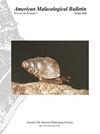Variation in Octopus bimaculatus Verrill, 1883 Diet as Revealed through δ13C and δ15N Stable Isotope Analysis: Potential Indirect Effects of Marine Protected Areas
IF 0.4
4区 生物学
Q4 MARINE & FRESHWATER BIOLOGY
引用次数: 7
Abstract
Abstract: Anthropogenic impacts on marine environments can be far-reaching and variable, and in an effort to mitigate these impacts, marine protected areas (MPAs) have been established globally. Indirect effects of MPAs on marine food webs and consumer behavior can be revealed through the diet of generalist predators, like octopuses, since their diet is a reflection of both preference and prey availability. Octopuses (Octopus bimaculatus Verrill, 1883) and invertebrate prey species were collected around Santa Catalina Island, CA in the summer of 2012, 2013, and 2014, and muscle tissues were analyzed for δ13C and δ15N. The δ13C and δ15N signature of octopuses caught within the MPA area and the non-MPA area were compared within diet space. Estimated contribution of prey species to octopus diet was calculated using a Bayesian mixing model. Octopuses caught in MPA areas had significantly different isotopic signatures than octopuses caught outside MPA areas in 2012 and 2013, but not 2014. Prey contributions to diet were highly variable between areas and years. Bivalves were a consistent contributor to MPA octopus diet, and the large snail Megastrea undosa (W. Wood, 1828) made up a relatively large proportion of the diet of octopuses from all areas and years. Additionally, there were more moray eels, a nocturnal predator outside MPA areas but more diurnal predators inside MPA areas. These results suggest octopus foraging behavior could be influenced by variation in predation risk reveal an indirect impact of diurnal predator recovery in the MPA. To fully understand the impact of anthropogenic change on marine environments, we must assess changes in the entire community and the interactions that drive community function.通过δ13C和δ15N稳定同位素分析1883年双爪章鱼饮食的变化:海洋保护区的潜在间接影响
摘要:人为因素对海洋环境的影响可能是深远和多变的,为了减轻这些影响,全球范围内建立了海洋保护区。MPAs对海洋食物网和消费者行为的间接影响可以通过章鱼等多面手捕食者的饮食来揭示,因为它们的饮食反映了偏好和猎物的可获得性。2012年、2013年和2014年夏天,在加利福尼亚州圣卡塔琳娜岛周围采集了章鱼(Octopus bimaculatus Verrill,1883)和无脊椎动物猎物,并对肌肉组织的δ13C和δ15N进行了分析。在饮食空间内比较了在MPA区域和非MPA区域捕获的章鱼的δ13C和δ15N特征。使用贝叶斯混合模型计算了猎物物种对章鱼饮食的估计贡献。2012年和2013年,在MPA地区捕获的章鱼与在MPA以外捕获的章鱼具有显著不同的同位素特征,但2014年没有。不同地区和不同年份的猎物对饮食的贡献差异很大。Bivalves一直是MPA章鱼饮食的贡献者,大型蜗牛Megastrea undosa(W.Wood,1828)在所有地区和年份的章鱼饮食中占相对较大的比例。此外,海洋保护区外有更多的海鳗,这是一种夜间捕食者,但海洋保护区内有更多的日间捕食者。这些结果表明,章鱼的觅食行为可能受到捕食风险变化的影响,揭示了MPA中捕食者日间恢复的间接影响。为了充分了解人为变化对海洋环境的影响,我们必须评估整个群落的变化以及驱动群落功能的相互作用。
本文章由计算机程序翻译,如有差异,请以英文原文为准。
求助全文
约1分钟内获得全文
求助全文
来源期刊
CiteScore
1.00
自引率
40.00%
发文量
1
审稿时长
>12 weeks
期刊介绍:
The American Malacological Bulletin serves as an outlet for reporting notable contributions in malacological research. Manuscripts concerning any aspect of original, unpublished research,important short reports, and detailed reviews dealing with molluscs will be considered for publication. Recent issues have included AMS symposia, independent papers, research notes,and book reviews. All published research articles in this journal have undergone rigorous peer review, based on initial editor screening and anonymous reviewing by independent expertreferees. AMS symposium papers have undergone peer review by symposium organizer, symposium participants, and independent referees.

 求助内容:
求助内容: 应助结果提醒方式:
应助结果提醒方式:


